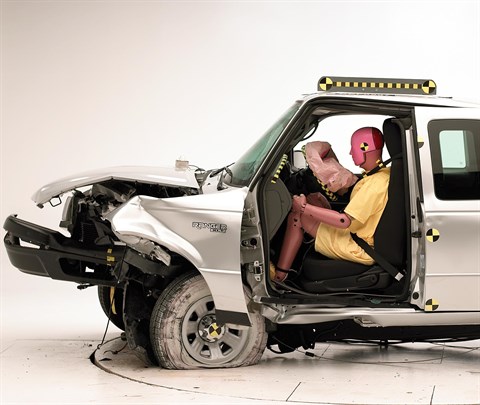Moderate overlap front: original test
Rating applies to 1999-2011 models
Tested vehicle: 2005 Ford Ranger XLT SuperCab 4x2
The Ford Ranger and Mazda B Series were redesigned for the 1998 model year. Extended cab models with four doors were introduced in the 1999 model year. The Mazda B Series was discontinued after the 2009 model year.
| Evaluation criteria | Rating |
|---|---|
| Overall evaluation | |
| Structure and safety cage | |
| Driver injury measures | |
| Head/neck | |
| Chest | |
| Leg/foot, left | |
| Leg/foot, right | |
| Driver restraints and dummy kinematics Dummy movement was reasonably well controlled. After the dummy moved forward into the airbag, it rebounded into the seat without its head coming close to any stiff structure that could cause injury. However, there was too much forward tipping of the driver seat and too much upward movement of the steering wheel. | |

Action shot taken during the frontal offset crash test.

The dummy's position in relation to the steering wheel and instrument panel after the crash test indicates that the driver's survival space was maintained reasonably well, but steering wheel movement and seat tipping were both excessive.

Dummy movement was reasonably well controlled, despite the excessive tipping of the seat. During rebound, the dummy's head hit the head restraint.

Forces on both lower legs were high enough to indicate the possibility of injuries.
Side: original test
Rating applies to 2010-11 models
Tested vehicle: 2010 Ford Ranger XLT SuperCab 2wd with standard front seat-mounted combination head and torso airbags
The Ford Ranger extended cab models with four doors were introduced in the 1999 model year. Beginning with 2010 models, side airbags for the driver and front passenger became standard (no side airbags were available previously in any Ranger model) and the front door trim was modifed to improve occupant protection in side impact crashes. Structure ratings are based on this test and on an earlier test of a 2008 Ranger model without side airbags. NOTE: the ratings are based only on the driver, and the side-facing rear jump seats weren’t tested because they are not recommended for safe transport.
| Evaluation criteria | Rating |
|---|---|
| Overall evaluation | |
| Structure and safety cage | |
| Driver injury measures | |
| Head/neck | |
| Torso | |
| Pelvis/leg | |
| Driver head protection | |
| Rear passenger injury measures | |
| Head/neck | |
| Torso | |
| Pelvis/leg | |
| Rear passenger head protection | |

View of the vehicle and barrier just after the crash test.

View of the vehicle after the crash with the driver door removed, showing the side airbag and damage to the occupant compartment.

The dummy's head was protected from being hit by any hard structures, including the intruding barrier, by a side airbag that deployed from the seat.

The side airbag provides protection for both the head and chest, as seen in this postcrash photo after the dummy was removed from the truck.
Roof strength
Rating applies to 1999-2011 models
Tested vehicle: 2010 Ford Ranger XLT SuperCab 2wd
| Overall evaluation | |
|---|---|
| Curb weight | 3,681 lbs |
| Peak force | 12,219 lbs |
| Strength-to-weight ratio | 3.32 |
Head restraints & seats
Seat type: Manual seats
| Overall evaluation | |
|---|---|
| Dynamic rating | |
| Seat/head restraint geometry |
About the head restraint & seat test
Currently, IIHS tests apply only to front seats.
